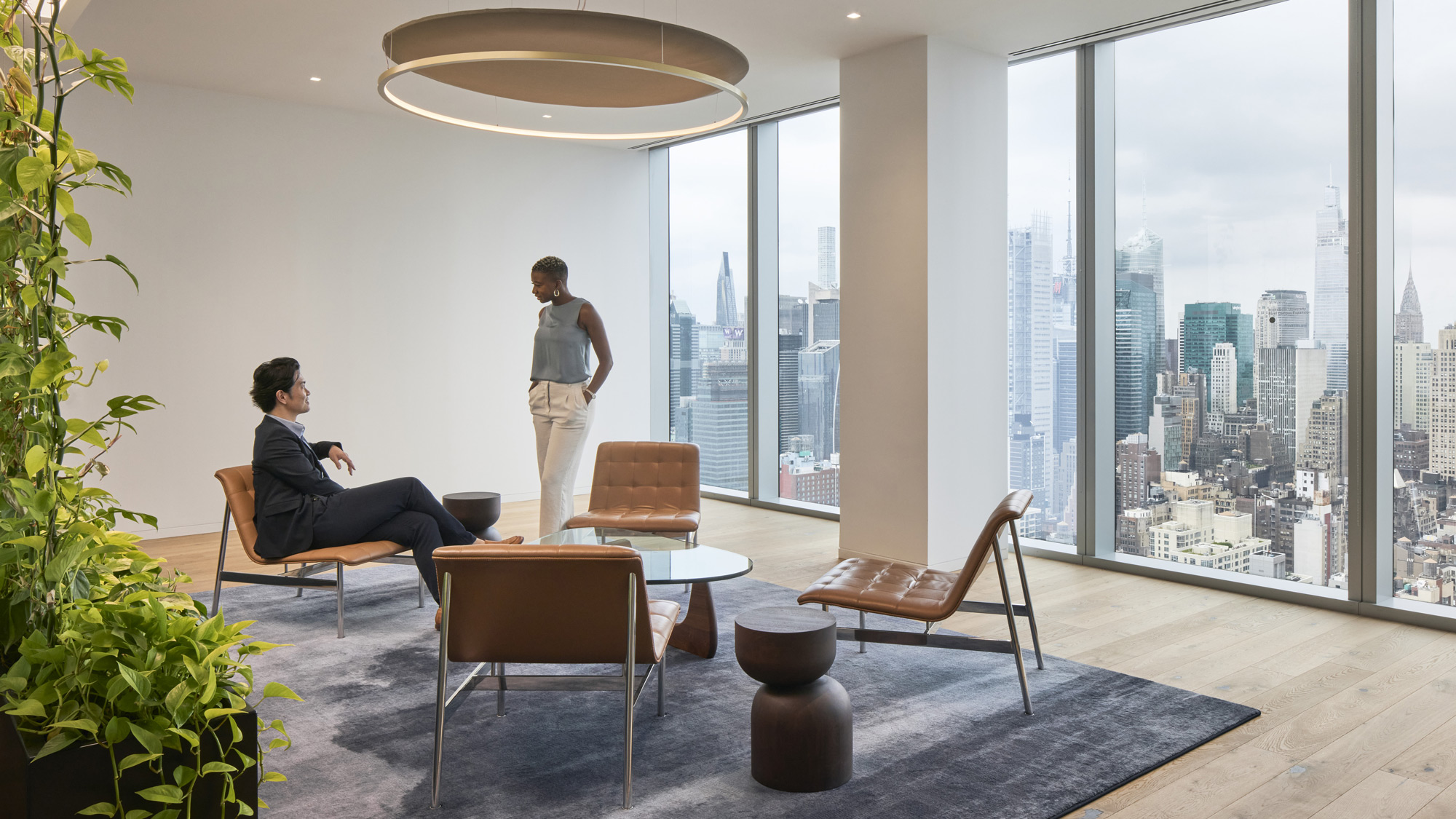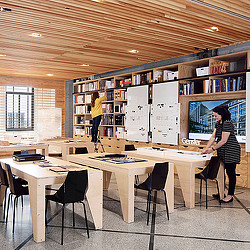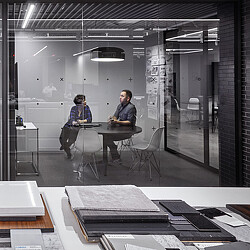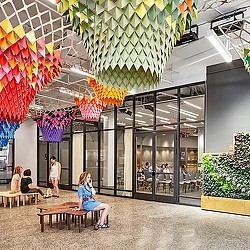Scaling Circular Design: Key Policies, Standards, and Strategies
As momentum grows for circular design, cities and clients face significant challenges and opportunities to implement it widely.

Nearly two decades ago, Carl Elefante coined the saying, “the greenest building is the one that is already built.” In a city like New York with lots of existing building stock, these words ring truer than ever.
Today, circularity in the built environment still faces obstacles in moving principle into practice. These challenges tend to fall into two categories: either (1) execution of circular concepts is perceived as too abstract and costly to plan for, or (2) execution is attempted too late in the design and construction process. As a result, significant opportunities are being missed because of inexperience with circular design and the opaque logistics of circular design strategies.
In New York, thanks in part to local policy and industry alignment – coupled with the ever-growing demand for housing and the shifting needs of workplaces – we’re seeing different circular design and construction practices cropping up. On job sites, selective deconstruction and verified reuse are cutting waste and preserving value, and interior fit-outs increasingly favor circular products that enable future reconfiguration.
Yet, according to the state’s 2024 report on circular construction, New York City generated 60 million tons of construction and demolition waste in 2019. A whopping 60% of the city’s solid waste is from construction and demolition, with an average of 7,500 tons being landfilled per day. While the momentum continues to grow, the scale of the problem requires widespread collective action. These statistics suggest that the industry is still designing and constructing in a largely linear fashion.
How do we bridge this gap and bring circularity into practice? What is working now, and where do we need to be looking in the years to come? Finally, how can policy, permitting, and procurement unlock the next wave of circular projects at speed and scale?
Understanding the Importance of Circularity
Bridging the gap starts with equipping practitioners, clients, developers, owners, and policymakers with a clear understanding of circularity as a core lever for reducing the built environment’s impact.
Designing and constructing spaces in the ‘make-take-dispose’ model results in:
- Rapidly depleting non-renewable natural resources.
- Generating excess emissions that contribute to climate change.
- Polluting the air, land, and water from landfilling.
- Harming disenfranchised communities.
- Disposing of assets that have legitimate technical and economic value.
Whereas designing and constructing for circularity:
- Lowers emissions by shortening a material's supply chain.
- Uses what is locally available and stimulates economies.
- Provides the feedstock needed for high recycled content/lower embodied carbon products.
- Minimizes the production of new materials altogether.

Circular Strategies with Significant Opportunity for Scale
In most instances, finding ways to reuse, repair, refurbish, redesign, resell, donate, recycle, or even downcycle materials is a significant opportunity to reduce emissions associated with our projects. To understand why, it helps to look at the estimated embodied carbon impacts of constructing and designing for circularity in the North American market.
For ground-up construction projects, steel and concrete structures are estimated to account for roughly 70% of a typical building’s embodied carbon, making the reuse of even the basic structural components one of the most significant opportunities for carbon savings. Reusing and recycling demolished materials are proven embodied carbon reduction strategies, avoiding emissions from waste disposal and reducing upfront emissions of manufacturing processes. A glass façade on commercial buildings can account for up to 30% of the embodied carbon footprint.
Of course, reusing façade materials must be weighed against the operational energy savings presented by upgrading to more efficient glazing, but in those instances where replacement is necessary for performance purposes, recycling demolished façade materials should be pursued. With interior fit-out projects, we’re seeing an average of 27% of a project’s whole life embodied carbon come from the replacement of materials over the course of a 20-year lease. When thinking about shorter lifespan projects and products, adaptability, flexibility, and planning for end-of-life need to become driving forces in how we design and construct, as this will ensure products are being used to their full potential.
Whether enacted during design, construction, demolition, or all of the above, these approaches require planning, partnership, and coordination across owners, project teams, and manufacturers. They also require policies to support adoption, infrastructure development, and cost regulation. The good news is that policies, projects, products, resources, and infrastructure are popping up globally to support these efforts, and infrastructure is starting to grow around them.
Policies Unlocking and Shaping Circular Design Strategies
In New York City, the newly enacted Clean Construction executive order sets ambitious but necessary requirements that all capital projects achieve a 75% diversion rate of construction and demolition materials, and that materials must be reused either on-site or within a new project. This policy supports our local economies while also creating a new network of resources needed for adoption to spread to non-capital projects. Right now, the city is seeing its first major campus project being disassembled with materials either reused or auctioned off in a public platform.
Meanwhile, in San Antonio, Texas, there is a deconstruction ordinance that’s been in place since 2022, stipulating that in order to receive a demolition permit, any house built before 1945 (or 1960 if located within a historic district) must be fully deconstructed. Materials from these projects feed into marketplaces for other projects, and the city is growing a skilled labor force to do this work. The city of Portland, Oregon, has had a similar ordinance in place since 2020. In 2025, Ireland released its roadmap for developing a circular built environment that is meant to supplement the nation’s zero-carbon plan by identifying opportunities for adaptive reuse, reducing materials, designing for circularity, and developing scalable circular business models.
We’re also seeing more clients set their own circularity requirements and goals. Several recent projects have focused on embedding opportunities to reconfigure their spaces with a minimal need for new materials at their current and future locations through the strategic use of demountable partition systems.
Projects and design standards alike are prioritizing products with extended producer responsibility (EPR) programs and that avoid hazardous classes of chemicals, which inhibit product recovery and recycling after deconstruction. Our design teams are utilizing existing onsite materials to both encapsulate a connection to local culture and history, all while reflecting an organization’s commitment to community engagement and sustainability.
We’ve also seen a notable rise in platforms that recirculate building materials and products, programs to repair and refurbish furniture, and products designed not only to be deconstructed and reinstalled but also to adapt to new dimensions.
As we continue to convert buildings from office to residential, we have a tremendous opportunity to divert the façade materials, which must be replaced, from landfills. These recycled materials will feed into new building products that contribute to operational and embodied carbon reductions.
Circularity will scale as long as we, as an industry, continue collaborating, educating, and institutionalizing it as practice. But in order to accelerate adoption, these strategies will be key:
- Design products for reuse and reconfiguration, not only for recyclability, and support them with programs and marketplaces that facilitate reuse and recycling locally.
- Create resources that quantify the efficiencies of circular construction and highlight economic and logistical benefits in addition to social and environmental impacts.
- Expand policies that decrease costs and incentivize circular design, including accountability measures.
- Institutionalize salvage assessments, circular demolition, and construction through standards and specifications on projects.
Alongside these practical strategies, the industry as a whole will need to continue to reframe our approach to design and construction. As we rethink how we design, build, and use our spaces, the variability of circular design and construction means there are new parameters in which to experiment and innovate. This shift impacts the entire built environment ecosystem, and every part of it has a responsibility to adapt.
For media inquiries, email .












